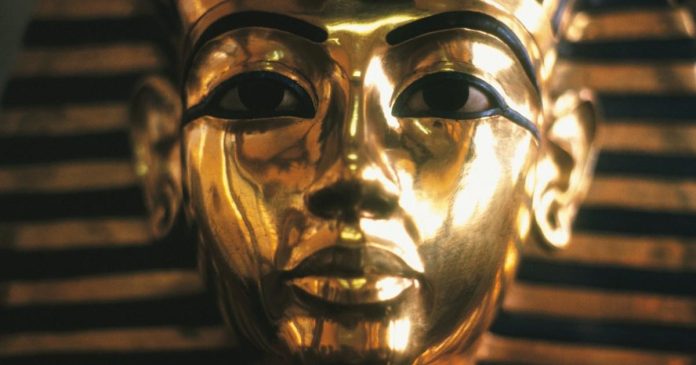Tutankhamun’s Curse: The Shocking Truth Revealed
In a stunning revelation, a scientist claims to have finally unraveled the mysteries behind the infamous ‘Pharaoh’s Curse’ that has haunted the world for over a century. And it’s not as supernatural as we once believed.
According to Ross Fellowes, a toxicologist, the curse that allegedly befalls anyone who disturbs the remains of an Ancient Egyptian person can be attributed to high levels of radiation and poisonous waste. These deadly substances have been trapped inside the tomb of Tutankhamun for over 3,000 years, wreaking havoc on those who dared to enter.
Since the tomb’s opening in 1922 by British aristocrat Lord Carnarvon and his team of archaeologists, a series of strange and tragic deaths have occurred. Lord Carnarvon himself fell victim to the curse just months after the tomb’s discovery, succumbing to blood poisoning caused by a mosquito bite on his face. His half-brothers also met untimely deaths shortly after visiting the tomb.
But the curse didn’t stop there. Prince Ali Kamel Fahmy Bey of Egypt was shot dead by his own wife in 1923, after paying a visit to the cursed burial site. George Jay Gould I, son of the renowned financier Jay Gould, also perished from a fever after exploring the tomb.
Even high-ranking officials were not spared. Sir Lee Stack, governor-general of the Sudan, was assassinated in 1924, and Howard Carter’s secretary, Richard Bethell, was found smothered in his bed in 1929.
The curse continued to claim victims in the following years. Howard Carter himself, the lead archaeologist who uncovered Tutankhamun’s tomb, passed away in 1939 from a heart attack, following a long battle with Hodgkin’s lymphoma. And in a chilling turn of events, the head of the Egyptian Antiquities Service was killed in a tragic road accident in the 1970s, shortly after agreeing to an exhibition showcasing the treasures from the cursed tomb.
It seems that the curse of Tutankhamun is not a supernatural phenomenon, but rather a deadly combination of radiation and toxic waste. The mysteries surrounding this ancient curse may finally have been solved, shedding light on the tragic fates that befell those who dared to disturb the resting place of the boy king.
British archaeologist Howard Carter removes artifacts from the tomb (Picture: George Rinhart/Getty)
The curse of the pharaohs has claimed the lives of several individuals involved in the excavation of ancient Egyptian tombs. These unfortunate souls met their demise in various ways, including asphyxia, stroke, diabetes, heart failure, pneumonia, poisoning, malaria, and X-ray exposure. Shockingly, all of them passed away in their 50s.
One notable figure, British Egyptologist Arthur Weigall, attended the opening of the tomb and was accused of inciting the myth of the curse. Tragically, he died of cancer at the age of 54.
Inscriptions found inside other burials throughout Egypt have revealed that the ancient people may have been aware of the toxins present in the tombs. Eerie texts have been translated, with one explicitly stating, “they that break this tomb shall meet death by a disease that no doctor can diagnose,” as Fellowes wrote.
A recent study conducted by the JSE shed light on the presence of high radiation levels in other Old Kingdom tombs, including those in Giza and Saqqara. The famous Osiris tomb in Giza also exhibited the same conclusion. Fellowes pointed out that intense radioactivity was particularly associated with two stone coffers, especially from the interiors.
Dr Zahi Hawass has the answer to the curse (Picture: AP)
Dr Zahi Hawass, a renowned Egyptologist, has a different perspective on the curse. He believes that the key to avoiding its effects lies in staying away from ancient bacteria. According to him, mummies inside tombs carry invisible germs that can be harmful.
To illustrate his point, Dr Hawass shared an anecdote about a sealed sarcophagus he recently encountered. Weighing a whopping 25 tonnes and buried 60 feet underground, the sarcophagus posed a significant challenge. With caution in mind, Dr Hawass took the necessary time to ensure safety.
After opening the sarcophagus, he left it exposed for half an hour to let the bad air dissipate and the fresh air circulate. Upon inspecting the contents, he found nothing amiss. For Dr Hawass, this is the true Curse of the Pharaohs.
While ancient bacteria may not make one more susceptible to assassination or murder attempts, Dr Hawass is determined to debunk the myth. He believes that the fame surrounding the curse grew when the tomb of Tutankhamun was discovered and exclusive rights were given to the Times of London. The subsequent death of Lord Carnarvon, the tomb’s discoverer, five months later sparked numerous untrue stories about the curse.

